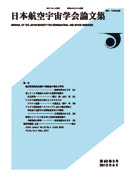All issues

Volume 49, Issue 568
Displaying 1-5 of 5 articles from this issue
- |<
- <
- 1
- >
- >|
Technical Paper(s)
-
Yuzo YAMAMOTOSubject area: Others
2001 Volume 49 Issue 568 Pages 135-140
Published: 2001
Released on J-STAGE: April 26, 2002
JOURNAL FREE ACCESSThe static instability of a slender front-free-aft-fixed elastic strip in the nuiform air stream the free end of which is the leading edge is studied analytically. The elastic strip is held vertically. The analysis is performed using the slender wing theory and beam theory and the effect of gravity force are considered that is the effect of the lateral buckling due to the gravity force. The approximate analysis is done by using energy method, and the static aeroelastic divergence speed is obtained. When the flexural rigidity approaches to the lateral buckling condition, the aeroelastic divergence speed becomes lower till zero wind speed.View full abstractDownload PDF (474K) -
Tohru ONOZAKI, Hideki SEKINESubject area: Others
2001 Volume 49 Issue 568 Pages 141-149
Published: 2001
Released on J-STAGE: April 26, 2002
JOURNAL FREE ACCESSThe inverse method has been developed for identifying force locations and force histories of point impacts acting on rectangular composite laminated plates without information on mechanical boundary conditions. The values of acceleration at several points on the plates are used as the measured values. Algorithms for the identification using a finite element method are presented for single and double point impacts. Then the mechanical boundary conditions at the edge of the plates are also identified together with the force locations and force histories of point impacts. In the numerical examples, the identification for cross-ply laminated plates and balanced laminated plates is examined in the cases of the measurement values with and without measurement noise. The validity of the present method is shown by comparing the identification results with exact ones.View full abstractDownload PDF (956K) -
Yasumasa HAMAGUCHISubject area: Others
2001 Volume 49 Issue 568 Pages 150-154
Published: 2001
Released on J-STAGE: April 26, 2002
JOURNAL FREE ACCESST 800 H/PMR-15 carbon/polyimide composite has good specific intensity and specific rigidity in high-temperature region to about 300°C. This material is an advanced structural composite to be applied to the elevons and other secondary structures of the unmanned space reentry vehicle HOPE-X. The authors have carried out the basic strength evaluation tests on this material. Especially, the compressive strength data is important for the structural design using composite material. Therefore, the compressive strength data was collected in various testing conditions (test temperature, stacking sequences, specimen configuration, moisture absorption condition) in order to examine the tendency in strength degradation by the temperature range from −50°C to 300°C. Empirical formula (approximate equation) which showed the relationship between test temperature and compressive strength was deduced from these test result. It is possible to simply show the relationship between test temperature (T) and compressive strength (S) according to the approximate equation of using three coefficient.View full abstractDownload PDF (562K) -
Yoshikazu SUITA, Teppei KUROKAWA, Junko SATO, Shinichiro SHOBAKO, Tepp ...Subject area: Others
2001 Volume 49 Issue 568 Pages 155-161
Published: 2001
Released on J-STAGE: April 26, 2002
JOURNAL FREE ACCESSThe GHTA (Gas Hollow Tungsten Arc) welding experiments were conducted under the simulated space environment that is vacuum and microgravity. A vacuum chamber for GHTA welding experiment was placed in the cabin of aircraft. Aluminum and titanium plates were employed as work pieces. The experiments proved that the arc discharge phenomena, welding phenomena and the micro-structure of weld metal receive almost no effect by gravity. In addition, it is also demonstrated that the weld metal of the plate welded under the simulated space environment hangs down less than that of the plate welded on the ground.View full abstractDownload PDF (1843K)
Technical Note(s)
-
Hirofumi EGUCHISubject area: Others
2001 Volume 49 Issue 568 Pages 162-165
Published: 2001
Released on J-STAGE: April 26, 2002
JOURNAL FREE ACCESSThe essential benefit of HardWare-In-the-Loop (HWIL) simulation can be summarized as that the performance of autopilot system is evaluated realistically without the modeling error by using actual hardware such as seeker systems, autopilot systems and servo equipments. HWIL simulation, however, requires very expensive facilities: in these facilities, the target model generator is the indispensable subsystem. In this paper, one example of HWIL simulation facility with a target model generator for RF seeker systems is introduced at first. But this generator has the functional limitation on the line-of-sight angle as almost other generators, then, a test method to overcome the line-of-sight angle limitation is proposed.View full abstractDownload PDF (569K)
- |<
- <
- 1
- >
- >|